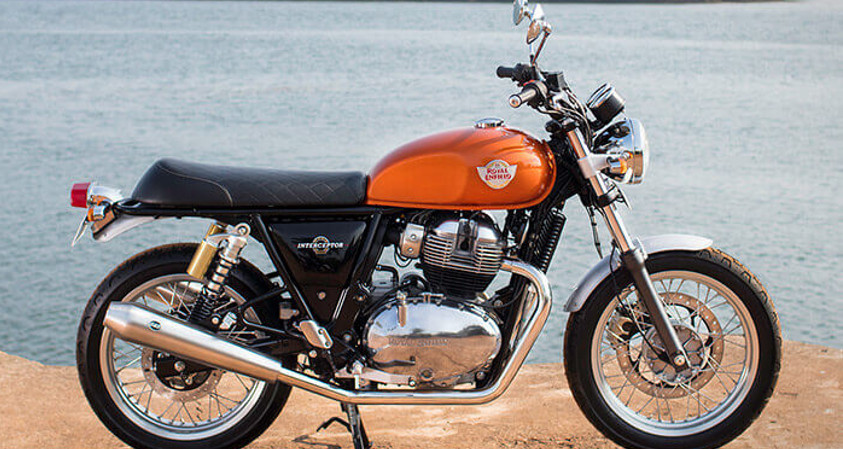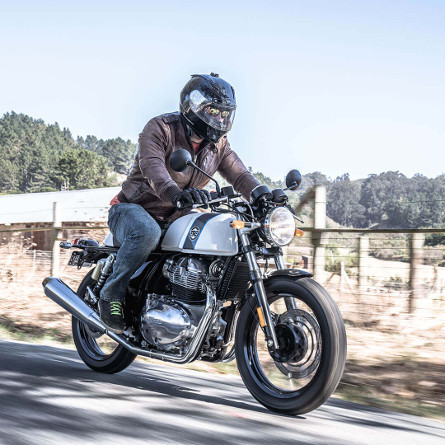Royal Enfield 650 Twins - The Interceptor and Continental GT
Remarkable new bikes with great modern engines and old fashioned style and good looks
In these somewhat gloomy times, we thought we’d have a look at one of the great motorcycling success stories out there, and Royal Enfield is certainly that. The marque has been quietly evolving and two of its recent offerings are the well-built, fun and good looking 650 twins the Interceptor and Continental GT. These motorcycles are based on those heroes of the past, the Royal Enfield parallel-twins from the 1960s – the age of cool.
A Blast From The Past
Claiming to be the world’s oldest motorcycle brand, Royal Enfield built its first motorcycle in the British Midlands in 1901 and opened an Indian branch in the 1950s to provide rides for the large market on the subcontinent. While the British company hit manufacturing sinkholes in the early 1970s and foundered, the Indian company managed to stay afloat and paddled along, keeping its head above water, with little changing until in 2000. That was when the 26 year old Siddhartha Lal took charge and that’s when the music started! From 50,000 motorcycles then, to around 800,000 now – they are clearly doing something right!
Under Lal the company has invested in state of the art manufacturing equipment in India and a research, development and test centre in the UK which employs over 100 people. This forward looking management has meant that Royal Enfield has gone from strength to strength with quality and design and it is really paying off. In a market in which motorcycle sales are declining, Royal Enfield is bucking the trend.
Interceptor 650
One of Royal Enfield’s latest superstars is the Interceptor 650, an upright tourer which is both nice to look at, fun to ride and super comfortable. Not perhaps that comfort is so much of a consideration for India where the average age for an Enfield owner is 27 – but it does increase its appeal worldwide where motorcyclists can be a trifle older!
Fun Times
The designers’ remit was to make this bike fun as well as practical, and they have achieved this in spades. The Interceptor sports an agile chassis with a good pedigree, developed at the UK Technology Centre by sports motorcycle frame builder Harris Performance, thus its handling is nimble and responsive without being intimidating. This, coupled with its nippy 47 horsepower engine, makes the motorcycle an entertaining ride. So what’s not to like you might be thinking? Well … that would be the suspension.
Ok let’s get down to specifics. It is a budget priced bike compared to your average modern machine but still has many good features. The brakes are Brembo subsidiary ByBre paired with Bosch two channel ABS and the tyres are Pirelli 18”. These do a grand job at cutting the speed safely, but is the Interceptor actually the whole nine yards - or maybe 7 and a half - simply because of the suspension…
When you hit a pothole - hard not to these days on British roads - you will feel it. The bike has very soft suspension, favoured by the Indian market, and it can wallow on fast bendy roads and struggle with corners. That’s the thing about budget suspension, but something has to be the weak link on a bike at this price level.
Boxing Clever
Apart from that the gearbox is 6 speed – an innovation of Royal Enfield’s own making and is smooth and slick and the engine is an air cooled 650 parallel twin. One of the other great things about the Interceptor is that the engine has a 270-degree firing interval which was a deliberate decision to give it that distinctive growly, gravelly sound like it’s ridden in through a rift in the space-time continuum from 1960.
Continental GT 650
Moving on to the Interceptor’s brother, the Continental GT. The Continental is a Cafe Racer extraordinaire, with many similarities to the Interceptor but a different look. It is based really on the stripped down look of the original 1950s Cafe Racer - lightweight and designed for speed rather than comfort. Fundamentally though, although it looks very different, the Continental only really differs from the Interceptor in a few ways: its tank has changed shape and has slightly less capacity, the handlebars are short clip-ons, not the wider ones of the Interceptor, its seat is a single not a bench seat and the footpegs are further back to change the rider’s seating position to a more streamlined racy one. But these differences between the two 650s do make for a very different ride.
Round the bend
Astride the Continental GT the rider is much more mobile and can move position to help with curves and cornering. Come to that, corners are nipped round sharpish on the Continental not waggled round like on the Interceptor and the open road is attacked with gusto and speed from a more streamlined motorcycle and rider. Despite all its racy good looks and the adjustments to the bike and rider position, Royal Enfield has cleverly maintained some comfort on the Continental GT and not sacrificed too much to the temple of speed.
It is also still reasonably versatile and practical despite its racy looks. There is some space to attach luggage to the frame and it has rear foot pegs so it is pillion-possible at a pinch – oh and it handles well in town traffic too.
And Finally…
So, on balance, two really good simple but effective motorcycles for a lot less money than their peers. They are thoroughly checked, in fact each machine, after manufacture, has a dedicated individual to give it a 1007 point 6 hour check to make sure all is well and functioning as it should, before it sets out to the big wide world. Royal Enfield has certainly achieved something here and the sales figures are the proof of the pudding. Not only are these motorcycles versatile, with a great engine and retro good looks, but it is easy to get Interceptor and Continental GT parts and to customise them if you want to upgrade. Already proving very popular, maybe it’s their functional simplicity which is part of the appeal in this over-complicated modern world. Perhaps another pair of long term style icons in the making here - time will tell.

